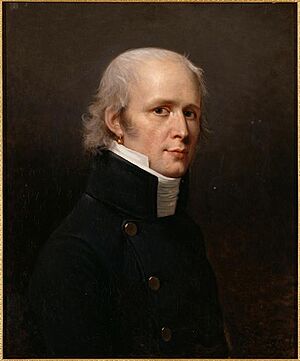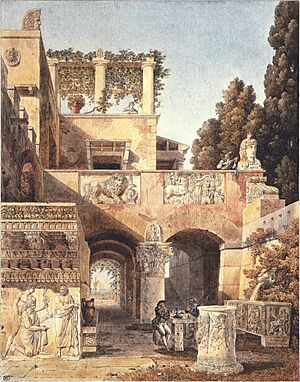Charles Percier facts for kids
Charles Percier (born August 22, 1764 – died September 5, 1838) was a famous French architect and designer. He created beautiful buildings and interiors in the neoclassical style. This style was inspired by ancient Greek and Roman art.
Percier worked very closely with his friend, Pierre François Léonard Fontaine. They were partners in everything they designed. It's almost impossible to tell which ideas came from Percier and which came from Fontaine. Together, they invented and popularized the grand and detailed neoclassical styles known as Directoire style and Empire style. These styles were very popular during the time of Napoleon Bonaparte.
After Percier passed away in 1838, Fontaine designed a special tomb for him. They had lived together as friends and colleagues. When Fontaine died in 1853, he was also buried in the same tomb, just as he wished.
Contents
Life and Work of Charles Percier
Charles Percier was born in Paris in 1764. When he was 19, in 1784, he won the Prix de Rome. This was a special government scholarship that allowed him to study in Rome, Italy. There, he met Fontaine, and their friendship and partnership began.
One of their first projects together was a book called Palais, maisons et autres édifices modernes dessinés à Rome. This book showed their designs for palaces and modern buildings in Rome. It helped them get attention from future clients when they returned to Paris.
In 1792, Percier became the supervisor for scenery at the Paris Opéra. This was a very important job for new and exciting designs. Fontaine returned from London, where he had been living, and they continued working together at the Opéra until 1796.
Working for Napoleon
Napoleon Bonaparte really liked their work. The Empire style they created was grand and impressive. It looked back to ancient Roman times, which Napoleon admired. This style was also different from the old royal styles, which suited Napoleon's new government.
Napoleon chose Percier and Fontaine to be his personal architects. They worked on many important projects for him almost until the end of his rule. Their partnership ended only when Napoleon left power. After the Bourbon kings returned in 1814, Percier and Fontaine were too closely linked to Napoleon. They did not receive any more official jobs from the new government.
After this, Percier opened a teaching studio for students. One of his students, Auguste de Montferrand, later designed the famous Saint Isaac's Cathedral in St Petersburg, Russia.
Designing Famous Buildings
Percier and Fontaine worked for ten years (1802–1812) on the Louvre palace. The Louvre had not been a royal home for a long time. This meant it was not connected to the old kings that many people disliked. It was also in the heart of Paris, so Napoleon could be seen there often. This was different from Versailles, which had been damaged and looted.
They also worked on the Tuileries Palace, which was across from the Louvre. In the famous square between them, the Place du Carrousel, Percier and Fontaine designed the Arc du Carrousel (1807–1808). This arch celebrated Napoleon's victory at the Battle of Austerlitz.
They also designed for other important places, including:
- Josephine Bonaparte's home, the Château de Malmaison.
- The Château de Montgobert for Napoleon's sister, Pauline Bonaparte.
- Changes and decorations for old royal palaces like Compiègne, Saint-Cloud, and Fontainebleau.
Interior Design and Influence
Percier and Fontaine designed every small detail inside the buildings they worked on. This included:
- Beds
- Tables
- Wall lights and candlesticks
- Chandeliers
- Door handles
- Textiles (fabrics)
- Wallpaper
They also published several books with their designs. One important book was Recueil de décoration intérieure concernant tout ce qui rapporte à l'ameublement (1812). This book showed their interior designs and furniture. The drawings in their books helped spread their style far beyond France. Their designs influenced the English Regency style and designers like Thomas Hope.
Percier's Students
At the end of 1804, Charles Percier officially stopped working on projects and focused on teaching. Here are some of his notable students:
- Auguste Caristie (1783–1862)
- François Debret (1777–1850)
- Joseph-Louis Duc (1802–1879)
- Martin-Pierre Gauthier (1790–1855)
- Alphonse de Gisors (1796–1866)
- Jacques Hittorff (1792–1867)
- Jean-Jacques-Marie Huvé (1783–1852)
- Louis-Hippolyte Lebas (1782–1867)
- Achille Leclère (1785–1853)
- Paul Letarouilly (1795–1855)
- Auguste de Montferrand (1786–1858)
- Bruno Renard (1781–1861)
- Louis Tullius Joachim Visconti (1791–1853)
See also
 In Spanish: Charles Percier para niños
In Spanish: Charles Percier para niños




